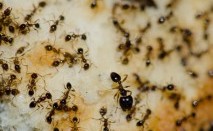
Category: Invertebrates

These marine invertebrates are known for the dazzling calcified colonies they create as they multiply and grow. Each colony is a collection of genetically identical coral organisms (polyps) that create their own calcium carbonate compartments which accumulate into the large skeletons we associate with coral reefs. Similar in structure to sea anemones, they capture tiny live prey with their tentacles as well as obtaining nutrients from symbiotic alga (zooxanthellae) that live within their tissues. Corals are very sensitive to pollution, blast-fishing, ocean-acidification, temperature change, and other disruptions to their environment.

It’s an ant’s world. We’re just living in it.
Do humans truly dominate the world? The Argentine ant may have something to say about that. Many ants are known for their large colonies, but the Argentine ant, named for its South American origins takes this to a whole other level. Due to inadvertent introduction by humans, the Argentine ant has spread to all continents except Antarctica. There are now three known super-colonies of these ants: one in Europe (the largest, covering 3,700 miles), one in California (560 miles), and another on the west coast of Japan. Ants are often territorial, but amazingly, ants belonging to the super-colonies recognize one another: if you were to introduce a super colony ant from Japan to one from Europe or California, they will recognize each other as friends!
Learn more >>
 Discover Animals is a web-based educational resource offered by the NAIA
Discover Animals is a web-based educational resource offered by the NAIA